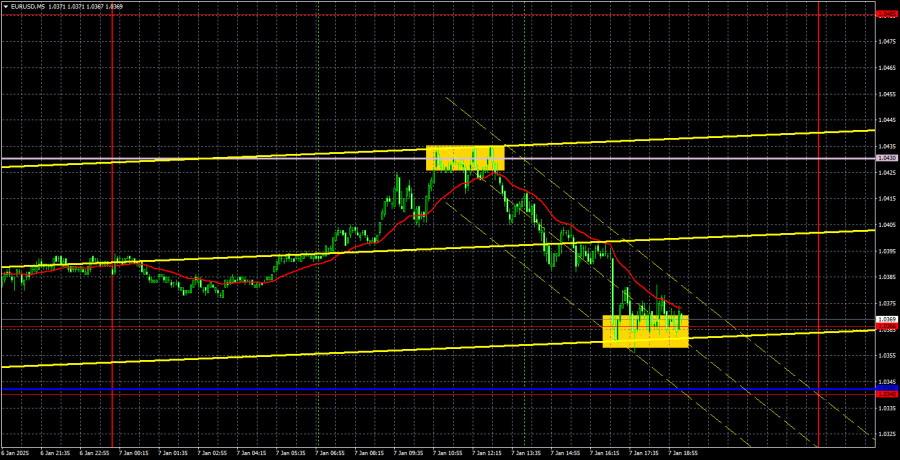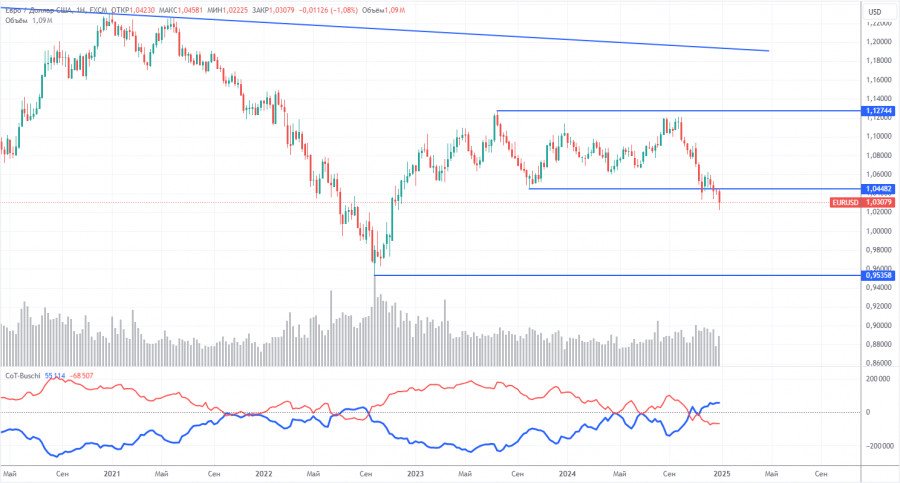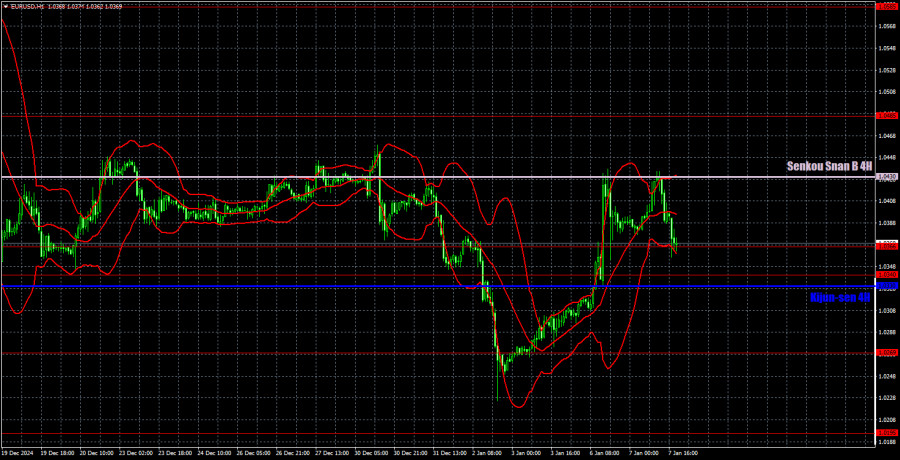EUR/USD 5-Minute Analysis

The EUR/USD currency pair made a second attempt on Tuesday to break through the Senkou Span B line, which has now fallen to the 1.0430 level. The charts clearly indicate two unsuccessful efforts to consolidate above this level, leading to a likely downward pullback. While the U.S. macroeconomic backdrop this week will play a crucial role, today's news is not expected to have a significant impact. Bulls will need a catalyst to surpass the strong resistance at the Senkou Span B line.
On Tuesday, market optimism among bulls hinged on the Eurozone's Consumer Price Index. Following a sharp increase in German inflation, many expected a similar rise throughout the European Union for December. However, the inflation rate in the EU fell within the anticipated range, which hindered the bulls from taking advantage of the momentum. In the second half of the day, the ISM services PMI in the U.S. surpassed expectations, strengthening the dollar. Currently, the euro lacks new catalysts to sustain its rally. This situation might change on Friday when the U.S. nonfarm payroll and unemployment reports are released, as they could potentially lead to dollar weakness. Federal Reserve policymakers have previously indicated that a "cooling" labor market is "acceptable," but they have stressed the importance of avoiding any further cooling. As a result, a contraction in the labor market or an increase in unemployment could trigger speculation that rate cuts in 2025 might exceed 0.5%.
Traders were given opportunities to open short positions with three bounces off the Senkou Span B line. By the evening, the currency pair had dropped to the 1.0366 level, where profits could be secured.
COT Report

According to the latest Commitment of Traders (COT) report, dated December 24, there has been a change in the positioning of non-commercial traders. While their net position had remained bullish for an extended period, bears have recently taken the lead. Two months ago, the number of short positions among professional traders surged, resulting in a net position that has become negative for the first time in a long time. This indicates that the euro is now being sold more frequently than it is being bought.
We still do not see any fundamental factors supporting the strength of the euro. For an extended period, technical analysis has indicated a consolidation zone, leading to a sideways market. On the weekly time frame, it is clear that since December 2022, the currency pair has been trading between 1.0448 and 1.1274. However, the recent break below the 1.0448 level has created new opportunities for further declines.
Currently, the red and blue lines in the COT chart have crossed each other and switched positions, signaling a bearish market trend. During the latest reporting week, the number of long positions in the "non-commercial" group increased by 6,800, while short positions grew by 9,400, leading to a further decline in the net position of 2,600.
EUR/USD 1-Hour Analysis

On the hourly chart, the currency pair has resumed its downward trend but underwent a sharp correction over the past three days. We believe this decline will continue in the medium term. The Federal Reserve is expected to reduce rates only 1 to 2 times in 2025, indicating a more hawkish stance than the market had anticipated. We still see no strong justification for significant euro growth, and the downward bias remains below the Senkou Span B line.
For January 8, the following trading levels are identified: 1.0195, 1.0269, 1.0340-1.0366, 1.0485, 1.0585, 1.0658-1.0669, 1.0757, 1.0797, 1.0843, and 1.0889, as well as the Senkou Span B line (1.0430) and Kijun-sen (1.0330). Ichimoku indicator lines may shift during the day, which should be considered when determining trading signals. Remember to set a Stop Loss at breakeven if the price moves 15 pips in the desired direction. This will safeguard against potential losses if the signal turns out to be false.
In the Eurozone, only a secondary report on German retail sales is scheduled for release. In the U.S., the ADP employment report and secondary jobless claims data will be published. Additionally, the formal minutes from the last Federal Reserve meeting will be released in the evening. It is unlikely that these events will trigger significant market movements.
Illustration Explanations:
- Support and Resistance Levels (thick red lines): Thick red lines indicate where movement may come to an end. Please note that these lines are not sources of trading signals.
- Kijun-sen and Senkou Span B Lines: Ichimoku indicator lines transferred from the 4-hour timeframe to the hourly timeframe. These are strong lines.
- Extreme Levels (thin red lines): Thin red lines where the price has previously bounced. These serve as sources of trading signals.
- Yellow Lines: Trendlines, trend channels, or any other technical patterns.
- Indicator 1 on COT Charts: Represents the net position size for each category of traders.
RobotFX















 Download NOW!
Download NOW!
No comments:
Post a Comment